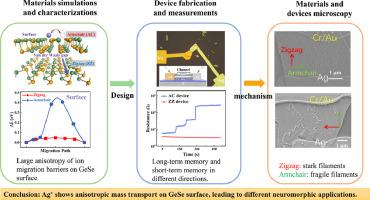Anisotropy is an intrinsic property in crystals with low structural symmetry, and such well-textured materials usually show distinct electronic transport and optical properties along different lattice orientations, offering wide applications in electronic and photonic devices. As a typical low-symmetry materials, crystalline GeSe with orthorhombic structure shows large electric and optical anisotropies. In this work, we take advantage of the anisotropic mass transport and filamentary growth of Ag ions on the GeSe surface to fabricate planar memristive devices which show directional memory and transient switching phenomena. The anisotropic switching behaviors stem from the distinct morphology of metallic filaments that are directionally dependent on the mobility of ions, e.g., ions diffusing along the low-barrier direction tend to form stark conductive channels while those with low mobility only entail slim and weak dendrites, which have been clearly observed under electronic microscopy. The functionality could be utilized to mimic various synaptic events, such as long-term memory enabled by stable conductive channels and short-term memory by the spontaneous rupture of weak filaments, all implemented in one physical device. Two integration schemes based on the anisotropic devices are designed and demonstrated for different application scenarios, paving the way for its applications in multifunctional brain-inspired computing systems.


